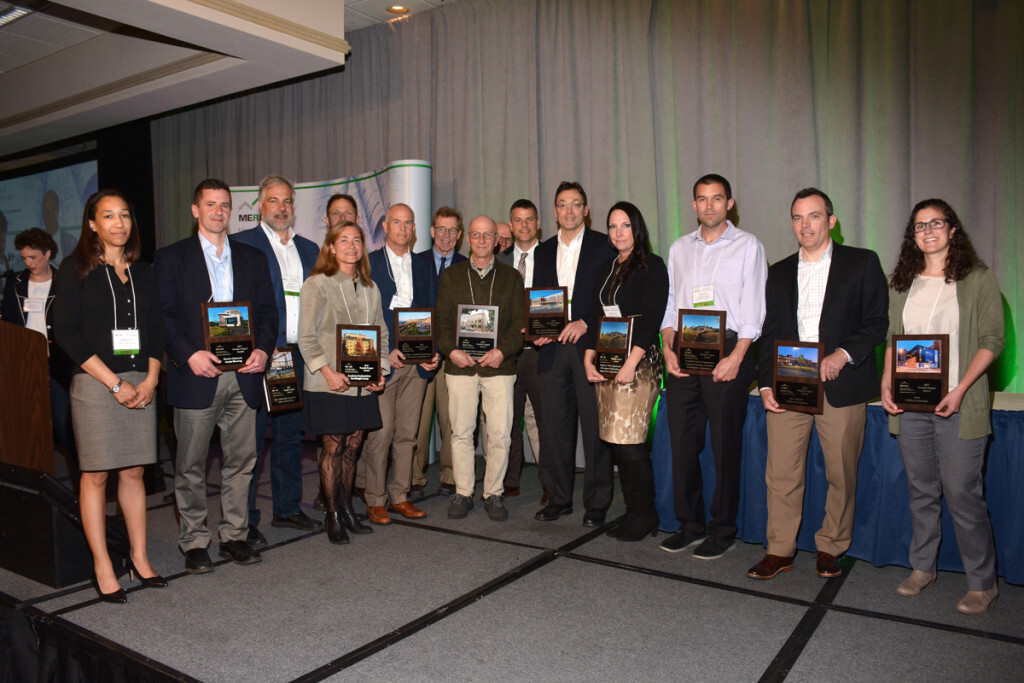The Maine Real Estate & Development Association (MEREDA), the state’s leading organization for responsible real estate development, honored the top ten real estate developments in Maine in 2017, and honored representatives from each with a prestigious “Notable Project” award at its conference in Portland on May 16.“The MEREDA board of directors selected exemplary projects from across the state, completed in 2017, which not only embody MEREDA’s belief in responsible real estate development, but also exemplify best practices in the industry, contributing to excellent jobs and increased tax bases for our cities and towns,” said Paul Peck, MEREDA board president and real estate developer. “We considered more than 50 worthy projects, following our selection criteria to narrow the list to ten award winners.”
Each of the ten winning projects was selected based upon criteria including: noteworthy and significant project completed* in 2017 (*Building Occupancy Permit must be issued by 12 31 17.), environmental sustainability, economic impact, energy efficiency, social impact, uniqueness, difficulty of development and job creation.
Highlights of each of the ten honorees are listed below.
- Anew Development’s 65 Munjoy Street in Portland: “65 Munjoy Condominium is a three-story, walk-up building offering eight high-quality, and amenity rich units in a range of 1, 2 and 3-bedrooms. 65 Munjoy presents the best of modern design and materials while respecting the traditional architectural forms, organization and massing that characterize Portland’s Munjoy Hill. 65 Munjoy is a unique and innovative response to Portland’s need for quality, efficient, ownership housing that is attainable by middle-income buyers. While the high quality and amenity rich units at 65 Munjoy appeal to buyers at any segment in the market, they were offered at reduced price points and made available exclusively to middle-income households.”
- Tedlum Associates’ Aura in Portland: “Aura is the transformation of a 1960s-era nightclub into a sophisticated, high-tech performance venue in the heart of downtown Portland. After nearly 20 years in business, Aura’s owners wished to expand and modernize its iconic entertainment venue, formerly known as Asylum. This “labor of love” presented many logistical challenges, including a tight urban footprint in a historic district, and the need to fast-track the project to keep staff employed during construction.”
- Portland Housing Authority & Avesta Housing’s Bayside Anchor in Portland: “This is a 45-unit, mixed-income, mixed-use Passive House Building located in the heart of the East Bayside neighborhood in Portland. The building has nine market-rate units and 36 affordable units targeted for individuals and families making between approximately $23,000 and $49,000 annually. Bayside Anchor is a service hub for low-income residents in East Bayside, giving the project its name as a stabilizing ‘anchor’ for the community. The street level is home to a Head Start preschool program and Community Policing and PHA offices. Bayside Anchor is PHA’s first new development in 45 years, and a first step in revitalizing their properties in this neighborhood. These homes, along with the community services Bayside Anchor offers, will further enrich this already vibrant neighborhood.”
- RBDD Cliff House Acquisitions’ Cliff House Maine in Cape Neddick: “The iconic Cliff House Maine, sitting on the edge of Bald Head Cliff in Cape Neddick, has been welcoming guests since 1872 but reemerged recently as one of the most captivating waterfront resorts of its kind. Leading investment firm, Rockbridge partnered with Maine hoteliers Marc Dugas and Peter Anastos to create RBDD Cliff House Acquisitions, LLC which purchased the property in 2014. The resort has been thoughtfully reimagined with extensive renovations and expansions to capture the best of Maine in every season. The resort recently completed a landmark transformation across 70 oceanfront acres. Cliff House reopened with newly designed guest rooms and suites, over 25,000 square feet of new meeting and event space, including a new cliffside ballroom, oceanfront dining and bars, indigenous landscaping, and many other enhancements. A new luxury spa and wellness center added to the already lengthy list of resort amenities.”
- Augusta Housing Authority & Developers Collaborative’s Hodgkins School Apartments in Augusta: “The Ella R. Hodgkins Intermediate School was constructed in 1958 as part of a comprehensive school building campaign in Augusta, to improve the quality of education for students of the city. The school is on the National Register of Historic Places, and is significant architecturally as an intact example of a modern, mid-century school building following the most recent trends in design and construction. While the building was vacant vandals broke skylights along with a considerable amount of the ridged glass block in the rear façade. Fortunately matching glass block was sourced to replace the damaged ones. Hodgkins School was one of the first buildings of its kind to be evaluated by the National Park Service that contained a large amount of glass block in its facade. Making this building not only unique to Maine, but also to the entire U.S.A. The NPS approval process for the glass block details required setting a precedent for future historic renovations of this era throughout the U.S.A. and thus required more than typical dialog between SHPO, NPS, Owner, and MaineHousing. This historically significant school was renovated into Hodgkins School Apartments resulting in 47 apartment units for low income elderly.”
- The Szanton Company’s Huse School Apartments in Bath: “Huse School Apartments involved the renovation of the former John E.L. Huse Memorial School, built in 1942 and 1949 in Bath. The elementary school was re-purposed to create 31 apartments and added a new construction wing with 28 apartments, for a total of 59 units. The project was financed using a combination of affordable housing tax credits and historic tax credits. The project provides quality affordable and market-rate apartments with amenities such as an elevator, fitness room, community room in a part of the re-purposed gym, laundry room, and more. Nearby amenities include Bath’s modern YMCA, the 5-mile Whiskeag Trail, and the bus line. Downtown Bath (with all of its services and attractions) is a half mile walk from the Huse School.”
- Avesta Housing’s Huston Commons in Portland: “Huston Commons is a Housing First development for 30 disabled individuals who have experienced chronic homelessness. Through a unique series of nonprofit collaborations, Huston Commons provides essential 24-hour support services, including a medical care room to accommodate regular practitioner hours and telemedicine services for residents, all of whom have disabilities. Avesta Housing is the developer and property manager for Huston Commons, and Preble Street provides the 24/7 supportive services. The project includes a partnership with Greater Portland Health to address specific health concerns and more generally ensure that residents have access to the health and personal care services that medically-compromised individuals typically benefit from in their homes. The onsite medical care room allows Greater Portland Health to schedule regular practitioner hours and telemedicine services for use in treating residents. Portland Housing Authority provides federal project-based rental assistance to all of the residents to make the rent affordable.”
- NewHeight Group’s Luminato in Portland: Luminato is 24 market-rate units ranging from 1 to 3 bedrooms at prices that ranged from the mid $200,000s to more than $1,000,000. Luminato embraces and promotes the concept of “living light” as part of a sharing economy Twelve one-bedroom units under 740 square feet were included in the design. All home owners benefit from the shared amenities – a guest room they can reserve for overnight visitors, a lounge for quiet time or small meetings, a well-equipped fitness room, and a roof deck with 360 degree views surrounded by a beautiful natural green roof. Intended to enable city dwellers to “buy small while living large,” Luminato residents enjoy forward-thinking features that help make day-to-day life hassle free—a dedicated mailroom where deliveries are out of sight and secure, indoor parking and racks for bikes, skis and paddles. Being the first to apply under the inclusionary zoning required creativity and engagement of several organizations. The Luminato project team collaborated with Community Housing of Maine to workforce housing units on a contiguous parcel versus contributing to the city housing fund. Luminato was the first newly constructed building in the Urban Transition district under the new India Street Neighborhood Form Based Code, creating an interesting facade with angled walls, inset decks, and as it gets taller, terraces that are surrounded by green roof that also provides the storm water management system.”
- Chinburg Properties’ Saco Mill #4 in Saco: “Saco Mill #4 is a mill redevelopment project that created 150 market rate apartments and 30,000 square feet of leasable commercial space. The project was an adaptive re-use of a long vacant mill building situated on Saco Island in the Biddeford-Saco Mills Historic District. The development team restored the mill to National Park Service standards. The four-story, 240,000 square foot 19th century mill was acquired by an affiliate of Chinburg Properties in December 2014. Construction began in September 2015. The apartments were completed in two phases, with the first 93 apartments completed on April 1, 2017 and the remaining 57 apartments completed on June 1, 2017. The apartments feature exposed brick and timber ceilings, beams and columns, polished concrete floors with radiant heat, kitchens with granite countertops and stainless steel appliances. The building also includes amenities such as a club room, roof-top deck, fitness center, dog wash & groom room, cyber lounge, café, and conference room. The commercial space at Saco Mill #4 includes Coldwell Banker Residential Brokerage and other locally owned small businesses. The project is noteworthy due to its sheer size, its recognition of the strong demand for downtown living outside of Portland, and the joint efforts of the developer, the City, and the developer’s financing team led by Maine-based Camden National Bank and Coastal Enterprises, Inc. to make the project a reality.”
- Zachau Construction for the Tyler Technologies expansion in Yarmouth: “Founded in 1966, Tyler Technologies is the leading provider of end-to-end information management solutions and services for local Government. Purchased from Cole Haan in 2008, the original 87,000 SF office building is located on Route 1 in Yarmouth. With offices throughout the country, Yarmouth is home to the Enterprise Resource Planning and School divisions. The campus also houses the company’s cloud-based services and is the location of several top executives including CEO & Chairman of the Board, and Falmouth native, John Marr. Jr. For Tyler Technologies, the expansion project represents the heart of a strategic growth plan that includes hiring 550 new employees by embracing Maine’s loyal workforce while positively impacting the community. The objective was clear; design and build a state-of-the-art office building that would provide workspaces and the technology infrastructure for people to collaborate, work, and play.”
For a complete list of honorees with full details, 051618 Notable Project boards 24×36 portrait.


